Please note: In October 2020, we updated the DXOMARK Camera test protocol. Version 4 now includes image preview tests and a wide range of new test scenes as part of our new trustability evaluation which measures the camera’s ability to deliver consistent still image and video quality across all shooting scenarios. We have retested this device using the new version 4 of the test protocol and produced this completely updated review. For more information, please see our article about preview, trustability and other version 4 updates of the DXOMARK Camera test protocol.
The first Google device to feature a dual-cam setup, the Pixel 4 implements both standard-wide and tele-lens cameras (but no ultra-wide) on the rear, with a single-lens camera on the front, essentially switching around the camera configuration from the Pixel 3. The primary camera is built around a 1/2.55-inch sensor with 12.2 MP resolution and 1.4µm pixels, coupled to a 27 mm-equivalent f/1.7 lens with optical image stabilization. Its second shooter features a 50 mm-equivalent tele-lens, providing around a x2 optical magnification for zoom shots, with a 16 MP 1/3.6-inch sensor capturing the images. For video, Google’s latest flagship can shoot 4K (2160/30 fps), but not in the default mode we use for testing, where it records footage at 1080p.
Like its predecessor, the Pixel 4 continues to offer automatic frame-rate switching between 30 and 60fps in videos shots at 1080p, and there’s a gyro-based stabilization system for smoother capture. Sophisticated software processing and computational photography in previous Pixel cameras has helped Google smartphones rank well in our tests. Combining this advanced processing with a dual-lens camera on the Pixel 4 could be really interesting.
Read on to find out how the Google Pixel 4 performed under the brand-new version 4 of the DXOMARK Camera test protocol.
Update summary
![]()
Google Pixel 4
With an overall updated DXOMARK Camera score of 113, the Google Pixel 4 charts in the bottom half of devices we’ve tested under our version 4 protocol. It fairs slightly better for stills where its Photo score of 120 helps the Google device leapfrog a couple of competitors, and for the most part it achieves a solid set of photo category scores, with an outstanding result for Photo color. Its overall Zoom score of 55 is impacted by the devices dual-camera set up with standard-wide and tele-lens modules, so there’s no score for the Pixel 4 in our ultra-wide category and tele-lens scores aren’t as impressive as the best performers. It’s a similar story for Video, where its score of 99 drops it behind the best, but again it achieves a fairly consistent set of results, with the exception of its video texture score, which is low compared to the 4K devices we’ve tested.
In our latest analysis, the Google Pixel 4 remains a solid performer in the flagship smartphone photography space. The lack of an ultra-wide shooter puts it at an immediate disadvantage against triple- or quad-cam devices in our scoring system, but it delivers pleasant results for standard-wide and tele-lens shots, thanks in part to its advanced computational processing technologies. Using the standard-wide, dynamic range is good in both indoor and outdoor conditions, so details in shadow and highlight areas are generally well maintained. It’s not very successful in our challenging backlit portrait scenes, however, where we noticed some underexposure.
Color rendering is a key strength, with standard-wide and tele-lens shots displaying vivid and pleasant color, with accurate white balance. Skin tone rendering is particularly impressive, recording faithful and neutral tones in people pictures. The flash unit also works well for night portraits, which again display nice color and exposure on faces. The zoom camera performs best at close range, with more than acceptable results at medium range, too. The 50 mm-equivalent tele-lens (essentially 2x magnification) isn’t ideal for long-range zoom shots, however, which display a noticeable loss of detail compared to the top-ranked devices for zoom in our database. But the Pixel 4’s main weakness in our testing is its texture-to-noise ratio. Noise is visible in all lighting conditions and especially in HDR portraits. Fine details are also lost in low-light conditions.
Conversely, when shooting video, the Pixel 4 handles noise well in all lighting conditions when tested in 1080p mode, which achieves the best compromise among texture, noise, stabilization, and frame rate. Its more aggressive video noise reduction, combined with 1080p capture, results in lower detail and texture scores compared to many of the top-ranked 4K devices we’ve tested, but at least you can be assured of clean, noise-free movies files from the Pixel 4. Video target exposures are mostly accurate, although dynamic range in bright outdoor conditions is slightly more limited compared to stills.
Color rendering is again a strength for video image quality, with neutral white balance and vivid color generally captured in all tested conditions. Video autofocus is fast, repeatable and accurate, with good tracking capabilities. The Pixel 4’s stabilization system is fairly effective for correcting unwelcome motion effects too, but we did notice some frame shifts in outdoor conditions, and artifacts such as color quantization and ghosting are also occasional visible.
Preview
Preview on the Google Pixel 4 offers some nice strengths, but also a couple of weaknesses due to the absence of some key features. It performs well for exposure representation in high-contrast scenes, thanks to very good HDR processing. If anything, the Preview image is slightly underexposed, though, so faces are often a little darker and highlights slightly better preserved than we see in the final image.
We took off points due to the lack of any bokeh simulation in the Pixel 4’s preview. While effective bokeh is often applied when shooting in portrait mode, the fact no visual indication of the effect is available in preview is a disadvantage compared to many other devices.
Features for zoom are limited in the default camera app, too. With no ultra-wide camera, the zoom range is restricted to 1x-8x magnification, and you can only pinch zoom, as there are no dedicated zoom buttons. Performance could be improved, too, with some noticeable jumps in the field of view and white balance instabilities when the device switches between its primary and tele cameras. Both focus and exposure remain fairly stable, however. So although there’s room for improvement, zoom smoothness isn’t terrible on the Pixel 4.
Google Pixel 4 camera review (originally published October 21, 2019)
The first Google device to feature a dual-cam setup, the Pixel 4 implements both standard-wide and tele-lens cameras (but no ultra-wide) on the rear, with a single-lens camera on the front, essentially switching around the camera configuration from the Pixel 3.
The primary camera is built around a 1/2.55-inch sensor with 12.2Mp resolution and 1.4µm pixels, coupled to a 27mm-equivalent f/1.7 lens with optical image stabilization. Its second shooter features a 50mm-equivalent tele-lens, providing around a x2 optical magnification for zoom shots, with a 16Mp 1/3.6-inch sensor capturing the images.
For video, Google’s latest flagship can shoot 4K (2160/30fps), but not in the default mode we use for testing, where it records footage at 1080p. Like its predecessor, the Pixel 4 continues to offer automatic frame-rate switching between 30 and 60fps in videos shots at 1080p, and there’s a gyro-based stabilization system for smoother capture.
Sophisticated software processing and computational photography in previous Pixel cameras has helped Google smartphones rank well in our tests. Combining this advanced processing with a dual-lens camera on the Pixel 4 could be really interesting. Read on to find out how the Pixel 4 performed in our DXOMARK Camera tests.
Key camera specifications:
- Dual-camera setup
- Primary: 12.2Mp 1/2.55-inch sensor with 27mm-equivalent f/1.7 OIS lens
- Tele-lens: 16Mp 1/3.6-inch sensor with 50mm-equivalent f/2.4 OIS lens
- PDAF autofocus
- Dual-LED flash
- 4K video, 2160p@30fps, and 1080p full HD (default)
- Video: Adaptive 30/60fps frame switching in 1080p default mode
About DXOMARK Camera tests: For scoring and analysis in our smartphone camera reviews, DXOMARK engineers capture and evaluate over 1600 test images and more than 2 hours of video both in controlled lab environments and in natural indoor and outdoor scenes, using the camera’s default settings. This article is designed to highlight the most important results of our testing. For more information about the DXOMARK Camera test protocol, click here. More details on how we score smartphone cameras are available here.
Test summary
With an overall DXOMARK Camera score of 112, the Pixel 4 ranks comfortably among the top ten devices in our database of smartphone image quality. Achieving a Photo sub-score of 117 points, Google’s latest device offers a nice step forward for stills over its predecessor, with noticeable improvements in most areas and a notable jump in the quality of zoom shots.
The Pixel 4 remains slightly behind such recent top performers as the Huawei Mate 30 Pro (121 points), largely due to the lack of both an ultra-wide camera and a time-of-flight (ToF) sensor. These omissions put the Google’s device at an immediate disadvantage compared to the triple- and quad-cam devices in our wide-angle and bokeh testing, and that affects its overall ranking.
Nevertheless, outstanding performance for video, combined with solid results for stills, ensures that the Pixel 4 remains a very attractive device for smartphone imaging enthusiasts. For photos, exposures are generally accurate, with good shadow detail in contrast scenes; and color is among the best we’ve seen. Accurate skin tone rendering is a particular strength for color, with generally well-controlled highlights on fair skin tones, nice levels of saturation, and pleasant white balance.
Fast and accurate autofocus ensures in-focus shots in all lighting conditions, and the level of detail is good in outdoor and indoor images, with intricate areas well-defined. It’s not quite as good in low light, however, where a loss of fine detail and a heavier buildup of noise are noticeable compared to results from the best low-light performers.
Zoom is the Pixel 4’s key strength, maintaining very good exposure, color, and detail in all our tests. It’s particularly impressive at close range, ensuring high levels of detail with well-controlled artifacts even in low-light scenarios, along with the same nice skin tone rendering on portraits. At medium and long range in bright light, it doesn’t preserve fine detail quite as well as the Huawei P30 Pro, but again, the Pixel 4 was often better at these focal ranges for indoor and low-light shots.
The Pixel 4’s bokeh simulation is pretty nice, too, thanks to pleasant exposure, color, and good overall image quality. It’s slightly let down by weaker depth estimation, however, with failures often visible at close inspection compared to top performers with a dedicated depth-sensing camera.
Google’s Night Sight mode is welcome for low-light photography, as it generally captures pleasant exposures with nice color and good detail. In our new series of night photography tests, auto-flash also triggers accurately based on the scene, and the flash automatically deactivates for low-light cityscapes, which show good exposure and strong color saturation. White balance tends to turn slightly pink, and details are low and have more noise than we’ve observed from the best devices in these shots, but the results are solid overall.
The Pixel 4 is also a top performer for video, ranking at the top of our database alongside the Samsung Galaxy Note 10+ 5G with a Video score of 101 points. All other recent top-ranked video devices have captured 4K (2160p) footage by default, however, making the Pixel 4 the first 1080p HD device to hit the top of our video rankings since the introduction of 4K recording at default settings. Excellent results for video noise, well-managed in all conditions, as well as video color with pleasant white balance and vivid rendering, are its key strengths. Video autofocus is also fast and accurate, and its gyro-EIS stabilization system is fairly effective, aside from some residual motion in walking videos. Automatic frame switching between 30/60fps in 1080p mode is also pretty handy for smoother video capture to keep pace with lighting or movement changes within a scene without having to manually adjust settings.
Photo scores explained
The Google Pixel 4 achieves a Photo score of 117 points, which is calculated from sub-scores in tests that examine different aspects of a device’s performance for still images under different lighting conditions. In this section, we take a closer look at how these sub-scores were determined and compare image quality against some key competitors.

Exposure and Contrast
Google Pixel 4
95
111
The Google Pixel 4 achieves an excellent score for Exposure, thanks to accurate target exposure in bright light and in indoor scenes. Images are slightly underexposed in low-light conditions tested in the lab, but shots are generally usable down to 5 lux, with acceptable brightness and good contrast. One noticeable improvement over the Pixel 3 is the handling of darker regions in many scenes. You can see in this reasonably bright indoor example below that the Pixel 4 offers much better brightness and detail for the darker skin tones and on the long-sleeved t-shirt of the model on the left. The Pixel 4 is also better for dynamic range compared to the Samsung Note 10+ 5G: in the scene below, it shows noticeably less highlight clipping of fair skin tones.
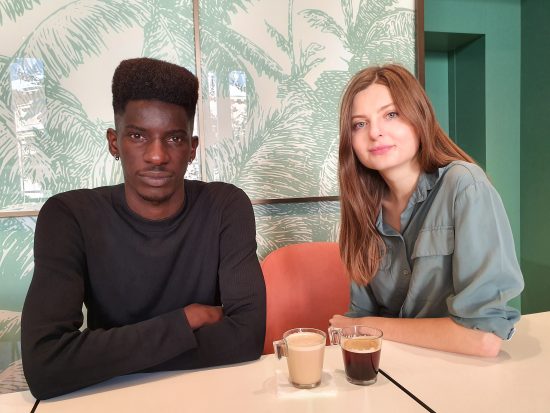
In very high-contrast scenes, the Pixel 4 continues with good detail in the shadow regions. Dynamic range is more limited in the highlights in very challenging scenes, however, with bright areas noticeably clipped. You can see in the samples below that while the Pixel 4 achieves similar exposure to that of the P30 Pro, the Samsung Galaxy S10 5G’s dynamic range is visibly wider, recording more color in the sky and preserving highlights outside the window better.
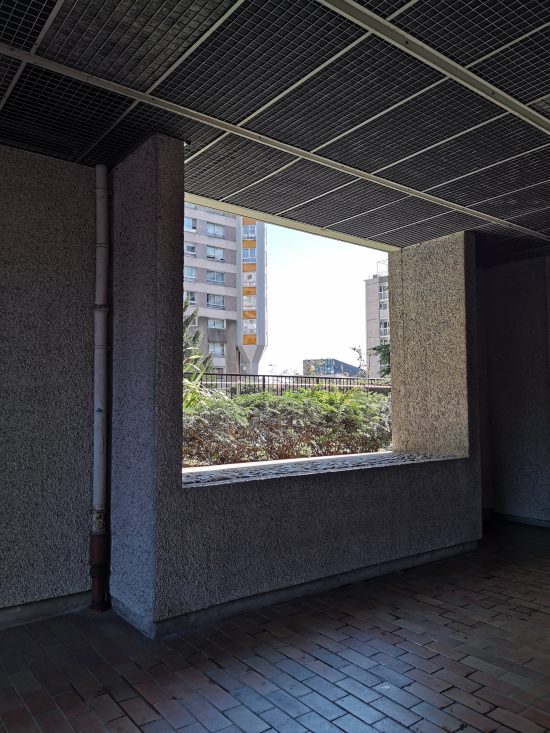
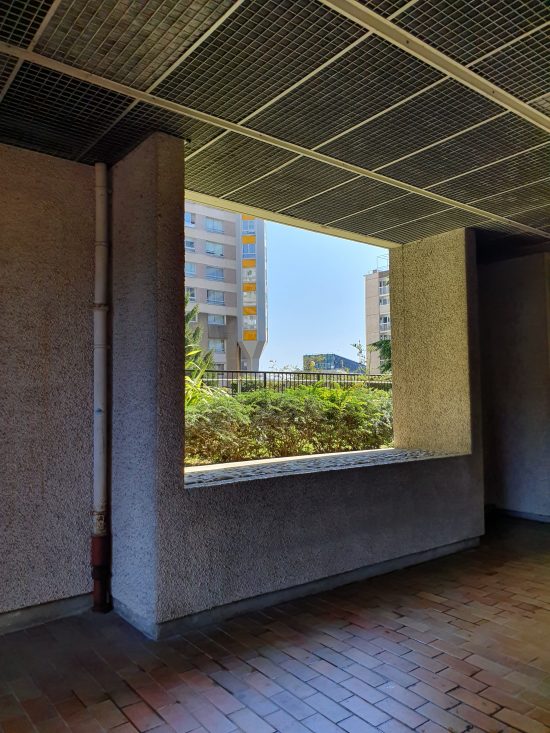

Color
Google Pixel 4
88
107
The Pixel 4 also nips at the heels of our top-ranked devices for color, with generally good saturation, accurate white balance, and nice skin tone rendering in all conditions. In outdoor shots, colors are bright and vibrant while looking natural and pleasant at the same time.
In this comparison, saturation is better on the Pixel 4 compared to the Huawei Mate 30 Pro; and while the Samsung Note 10+ 5G is the punchiest of the three, the Pixel arguably offers more faithful color rendering, particularly of the reds.
In bright sunny conditions, the Pixel 4’s white balance does tilt towards the warm side generally, but the effect is pleasant, and it avoids strong color casts. In the same example above, the Mate 30 Pro displays a slight magenta cast, and although the Note 10+ 5G shot is similar to the Pixel 4’s, its white balance is just a little too warm.
The Pixel 4’s excellent color and skin tone rendering is also visible in the shot below, with better saturation compared to the Mate 30 Pro, and more faithful color compared to the slight yellow cast visible in the shot from the Note 10+ 5G.

Autofocus
Google Pixel 4
99
109
The Pixel 4 autofocus performed well in our lab tests and out in the field, with no focus failures shooting natural test scenes. You can see in our lab analysis comparison below that the Pixel 4 consistently delivered sharp shots over 30 consecutive frames under indoor lighting.
There’s a greater variation in focusing speeds compared to the Mate 30 Pro and the S10 5G, which are a bit more consistent, but the Google device is generally quicker to snap into sharp focus compared to the S10 5G. Some over-sharpening is evident compared to the P30 Pro, with the Pixel 4 pushing acutance over 100%, but sharpening is less aggressive than the S10 5G’s in the same tests.

Texture
Google Pixel 4
72
111

Noise
Google Pixel 4
70
102
Update as of 31 October 2019: The latest tested devices introduced advanced technologies that dramatically enhance details. To highlight these new capabilities, we decided to reshape our texture evaluation scale to award the best-performing devices a higher score.
The Pixel 4 drops off the pace somewhat compared to the best performers for texture and noise. In bright light, as well as indoors generally, it renders texture nicely and preserves details fairly well. A minor loss of fine detail and softer edge definition is sometimes evident at close inspection compared to such top devices as the P30 Pro, however.
Where differences in detail become more noticeable is in very low light. While the Pixel 4’s acutance levels are broadly consistent with those of the Mate 30 Pro and the S10 5G in most lab conditions, detail drops off much quicker in light conditions below 20 lux in handheld shots. That said, at over 60% acutance, detail remains very acceptable at 5 lux, so it’s really only in the near-dark condition of just 1 lux that detail drop-off is problematic. It’s worth noting, too, that the Pixel 4’s exposure time was fairly long under these conditions, so supporting the phone should help reduce camera shake and improve detail in extreme low light.
The Pixel 4 controls noise is fairly well in outdoor and indoor images, and although luminance noise is sometimes visible in flat areas of color, it’s not overly offensive. A stronger buildup of noise is evident in the dark areas of high dynamic range scenes, though. You can see in our indoor backlit portrait that the Pixel 4 has done a good job of lighting up the face and wall, but at the expense of more noise compared to the P30 Pro and the S10 5G.
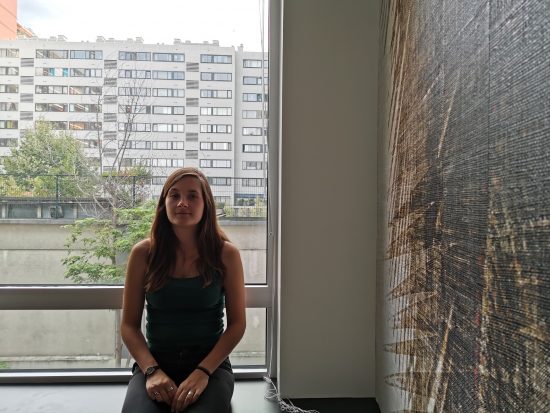

Artifacts
Google Pixel 4
74
77
We applied penalties to the Pixel 4’s score for a number of obvious artifacts, the most problematic of which are heavy ringing, which is commonly visible along high-contrast edges, and a loss of acutance towards the edges of the frame, which is very noticeable when viewing images at large scale. Colored maze and moiré patterns are also evident under close inspection of high-frequency areas. We also observed some flare effects as well as colored fringing in backlit images, but these issues are less common and not as problematic generally.

Zoom
Google Pixel 4
81
The Google Pixel 4 shows a big improvement for zoom over the Pixel 3, thanks to the addition of the second tele-lens working in combination with Google’s super-resolution algorithm that combines multiple frames for sharp results. The Pixel 4 is now comfortably among the best zoom performers at close and medium range, with good edge definition in outdoor and indoor shots, and naturally-rendered details in portrait shots. It maintains good exposure with similar levels of dynamic range in zoom shots as well, and although white balance in outdoor shots remains slightly warm, overall color rendering is good.
In the example below, the Pixel 4’s advantage for detail over its predecessor at medium range is clear, and although top performers like the Mate 30 Pro just edge it in very intricate areas, there’s not much in it.
A slight loss of very fine detail is evident using long-range zoom, which dropped it just behind the top zoom devices in this category. That said, the Pixel 4 continues to perform admirably at long range, with results very close to the top performers in many examples.
In fact, using long-range zoom indoors, the Pixel 4 not only outperformed the S10 5G, but also the Huawei P30 Pro (equipped with a 5x tele-lens) for fine detail preservation.
So on the whole, a very solid performance in this category, though our testers did observe a few other issues worth noting: maze patterns are often visible at long range indoors, as well as a sight yellow color cast at close range. Ringing artifacts also persist in outdoor zoom shots generally, and sometimes we found faces to be out of focus.

Bokeh
Google Pixel 4
60
80
The Pixel 4 achieves a good but not great score for bokeh, so has an opportunity for improvement in future iterations. Overall image quality is pretty good, and in many examples, exposure, color rendering, and skin tones are more pleasant in the Pixel 4’s bokeh shots compared to some of its key competitors’.
The main drawback is depth estimation, however, with the lack of a dedicated depth-sensing or ToF sensor putting the Pixel 4 at a disadvantage. Depth estimation failures are often visible, including blurring of intricate areas on the subject, as well as blur gradient errors in the background, where sharp artifacts often occur.
In the example below, the strong depth-of-field effect applied by the Pixel 4 looks striking, but its depth estimation isn’t anywhere near as good as that of the Note 10+ 5G at close inspection. Where the Pixel 4 blurs the subject’s earring and displays edge artifacts around the ears, the Samsung is capable accurately masking in these complex areas and applying a more realistic effect as focus drops away behind the face.

Night
Google Pixel 4
56
82
At 56 points, the Pixel 4 isn’t quite a top performer under our new Night protocol testing either, but it produces solid results; moreover, Google’s Night Sight mode is capable of producing noticeably better results than standard mode in difficult conditions. In this dedicated mode, exposure is usually very good, even in very low light, with accurate white balance and very good color rendering. Details both on the subject and in the background are generally well-maintained, aside from some ghosting evident on moving subjects.
In the comparison below, you can see that Night Sight achieves good exposure on both subject and background, while the background is strongly underexposed in the flash-auto image. Color rendering in the background is much better using Night Sight, with more natural colors as well.
In auto-flash mode, the flash triggers when it should, accurately firing when the camera detects a portrait scene. Exposure for low-light cityscapes is generally accurate, and although a slight magenta white balance cast can very occasionally be visible, color rendering is fairly good, with high levels of saturation maintained.
The main drawback for night shots compared to such top performers as the Huawei P30 Pro, however, is a strong buildup of both luminance and chromatic noise, and low levels of detail with the flash turned off.
Video scores explained
With an overall Video score 101 points, the Google Pixel 4 is the joint leader in our video ranking, sharing the top spot with the Samsung Galaxy Note 10+ 5G. The overall Video score is derived from performance and results across a range of attributes in the same way as the Photo score: Exposure (87), Color (92), Autofocus (95), Texture (61), Noise (86), Artifacts (90), and Stabilization (94).
What’s particularly unusual about the Pixel 4’s excellent video score is that it achieved it when recording at 1080p Full-HD resolution as opposed to the 4K resolution that all other top-performing video devices use at default settings. Naturally, this means that the Pixel 4 scores a little lower for texture than most direct competitors, with a particular lack of fine detail in low light, but it makes up for it in almost all remaining test categories.
Target exposure is accurate and stable down to low light. Dynamic range is fairly wide, but not as good as the best devices, and we observed some highlight clipping in high-contrast scenes. Color rendering is generally very nice, with accurate and stable white balance. Only during changes of illumination did we see some instabilities during convergence.
Noise control is one of the video mode’s key strengths. Noise is very well-controlled in all light conditions down to low light, with very low levels of visible spatial and temporal noise. The Pixel 4 also achieves a very good score for artifacts in video mode, which is partly due to much-reduced judder effect when panning, thanks to a higher frame rate when shooting in bright light.
The autofocus system works swiftly and reliably in video and is good at tracking subjects. Video stabilization is good, too, with some motion visible in the footage only when recording while walking. There are still some areas for improvement, but as things stand, the Google Pixel 4 is currently one of the very best devices for mobile video.
Conclusion
Previous Pixels have generally outperformed other single-cam devices in our database thanks to Google’s advanced software processing and super-resolution algorithms. With its key competitors continuing to add more lenses and sensors to their flagships, however, there was a danger Google would seriously drop off the pace.
The dual-cam Pixel 4 allays those fears, and the introduction of a second tele-lens makes it one of the best performers for zoom on the market that we’ve tested. It’s a solid performer in most other areas for stills, too, not to mention achieving joint top rank for video, with exceptional results for color, noise, and artifacts in moving images.
Adding an ultra-wide-angle third camera and dedicated ToF sensor for bokeh shots will be needed in future iterations, however, if the Pixel is going to meet the challenge for a spot at the very top of our rankings for stills.
Photo
Pros
- Vivid and pleasant colors in bright light
- Usually good exposure in all conditions
- Fast and accurate autofocus in bright light
- Good color and exposure in flash-auto mode
- Good detail at close- and medium-range zoom
Cons
- Some loss of detail and visible noise in all conditions
- Localized loss of acutance, ringing, and moiré patterns in bright light
- Occasional depth estimation artifacts in bokeh mode
Video
Pros
- Noise well under control in all conditions
- Good detail in outdoor and indoor recording
- Good target exposure and fairly wide dynamic range
- Vivid colors and pleasant white balance
- Fast, repeatable, and accurate autofocus
- Fairly effective stabilization
Cons
- Some noticeable motion in walking videos
- Lack of fine detail in low light









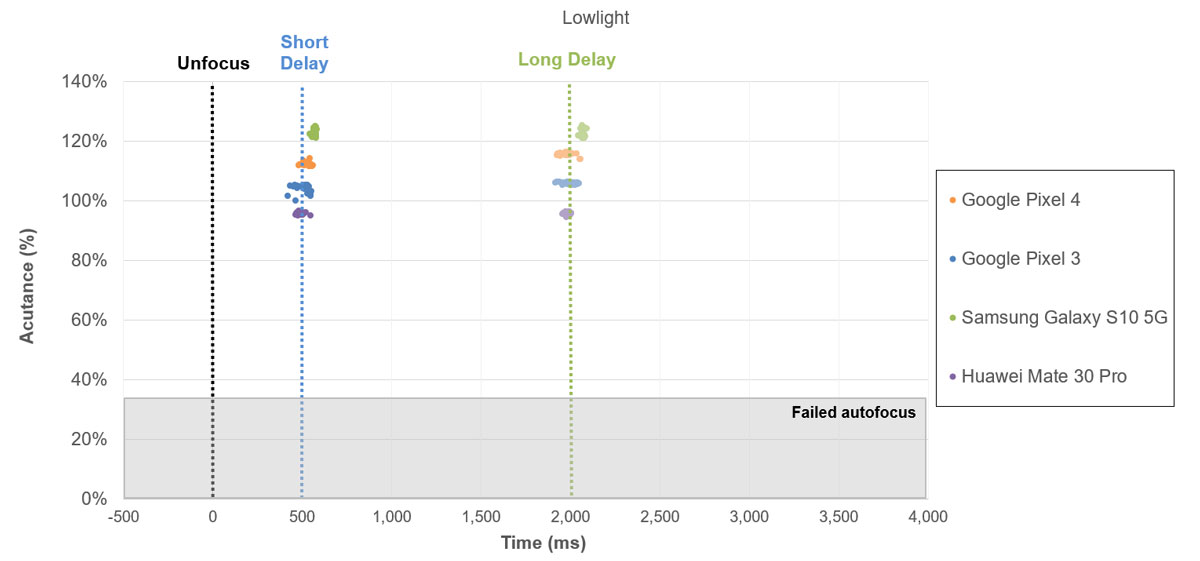


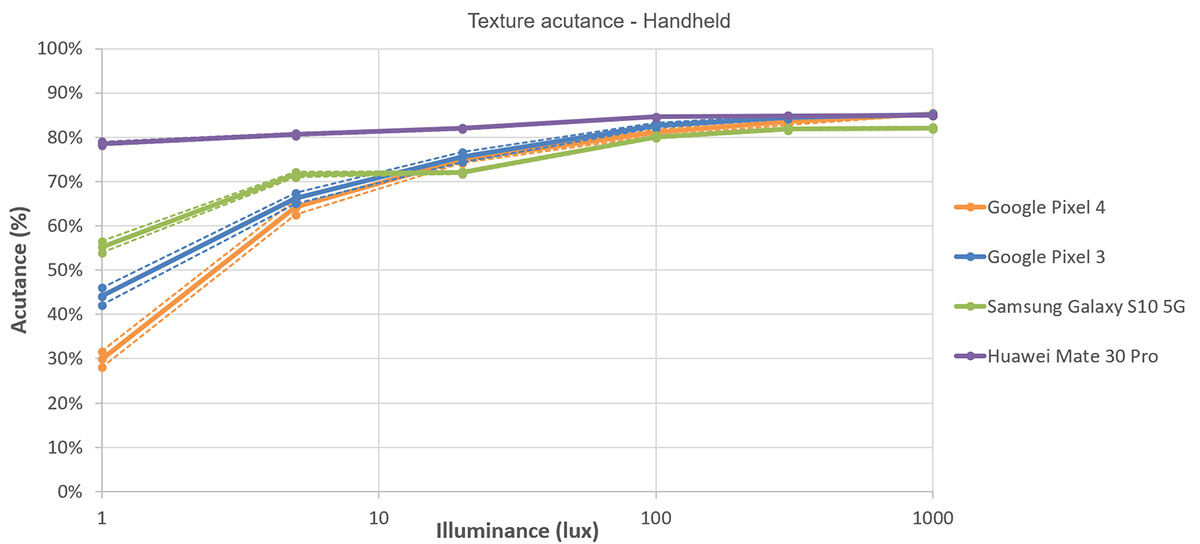
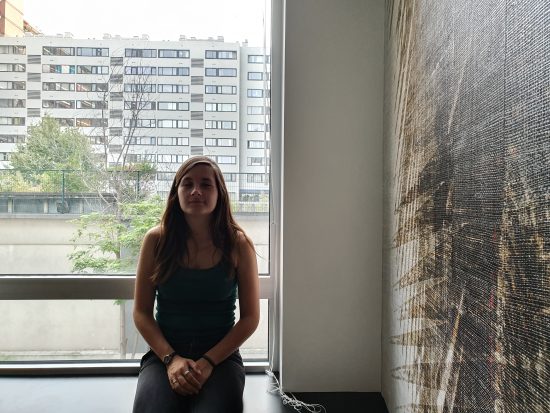
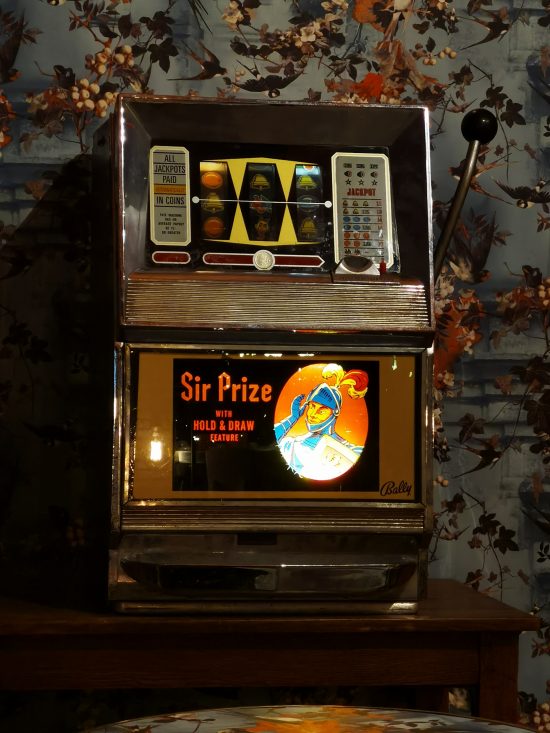

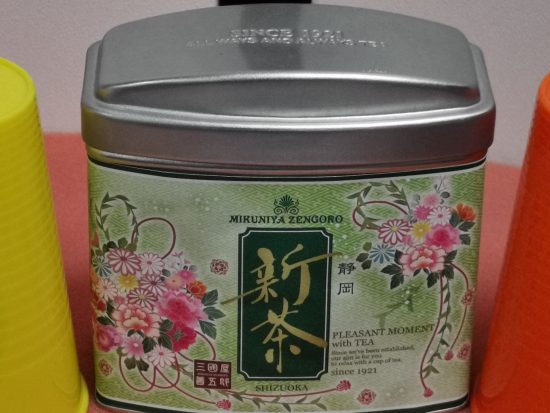
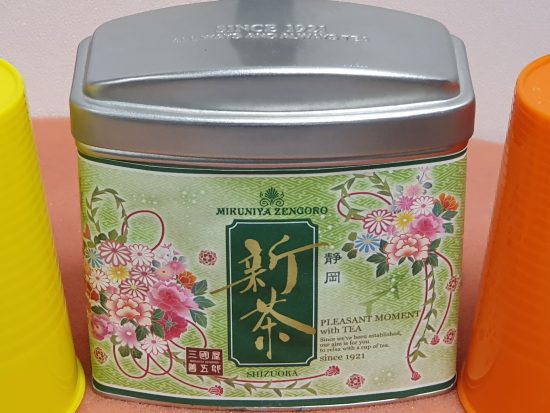



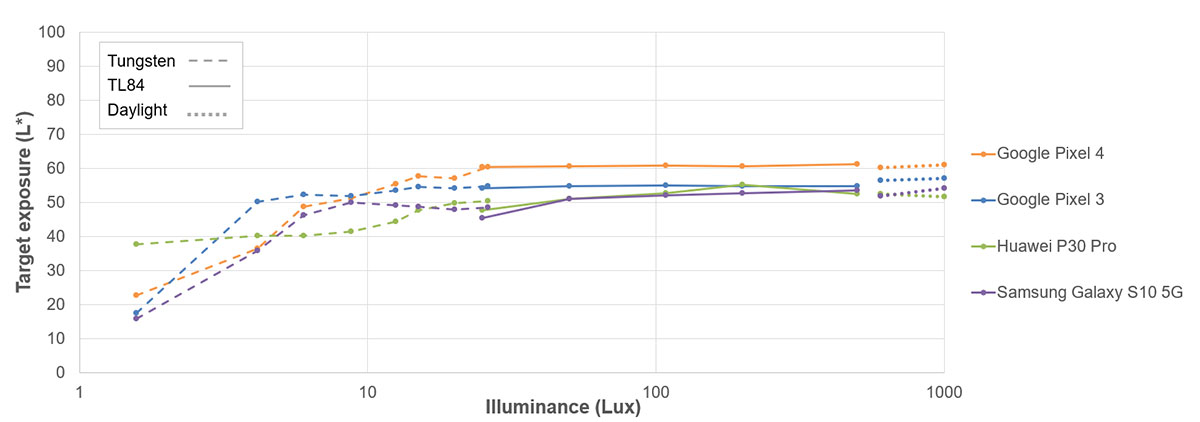
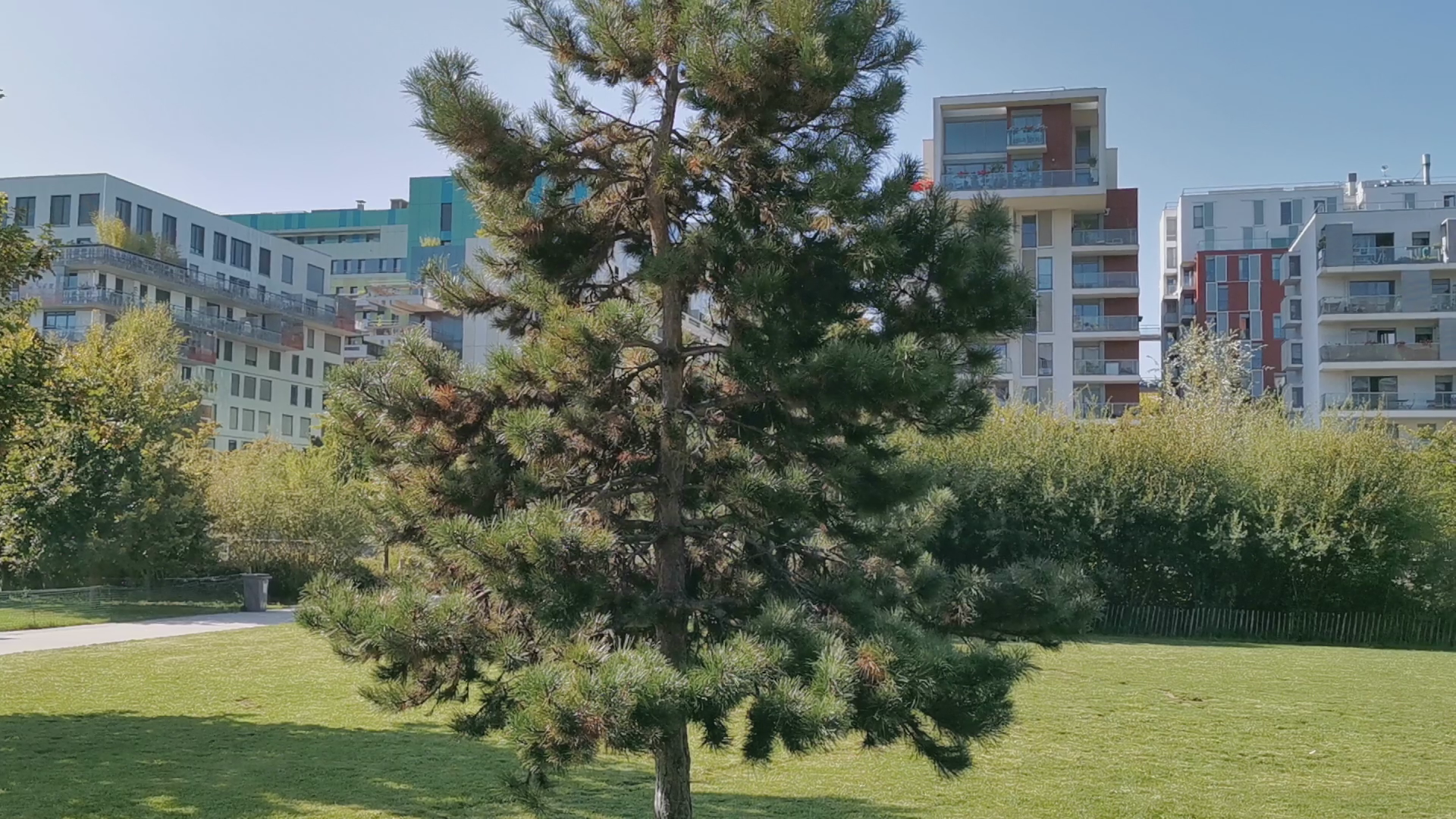
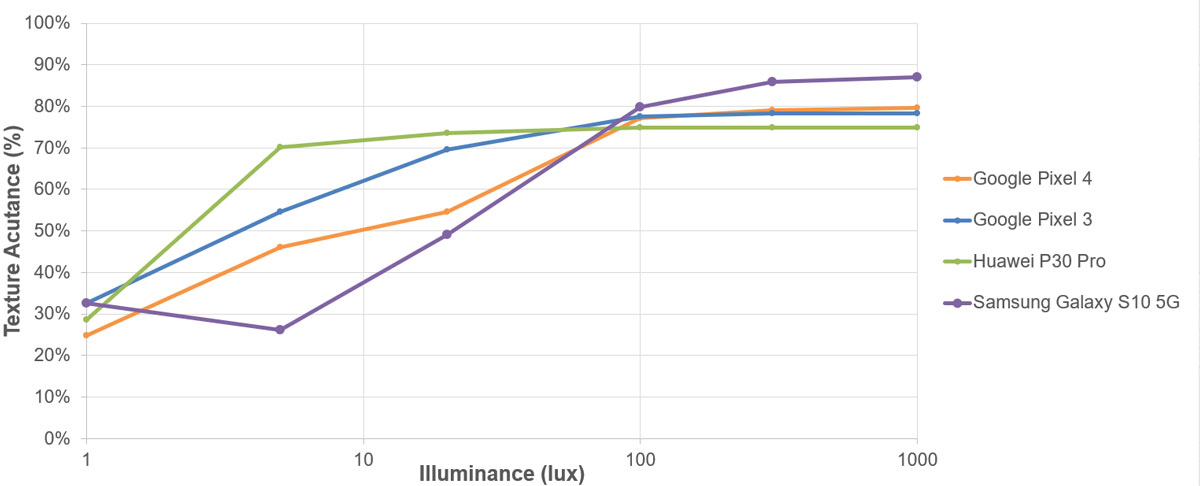
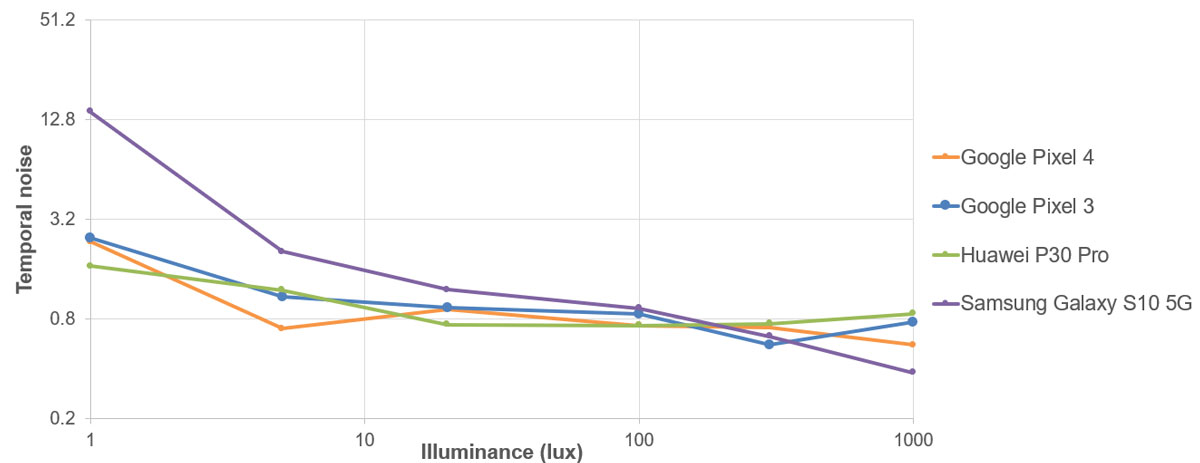
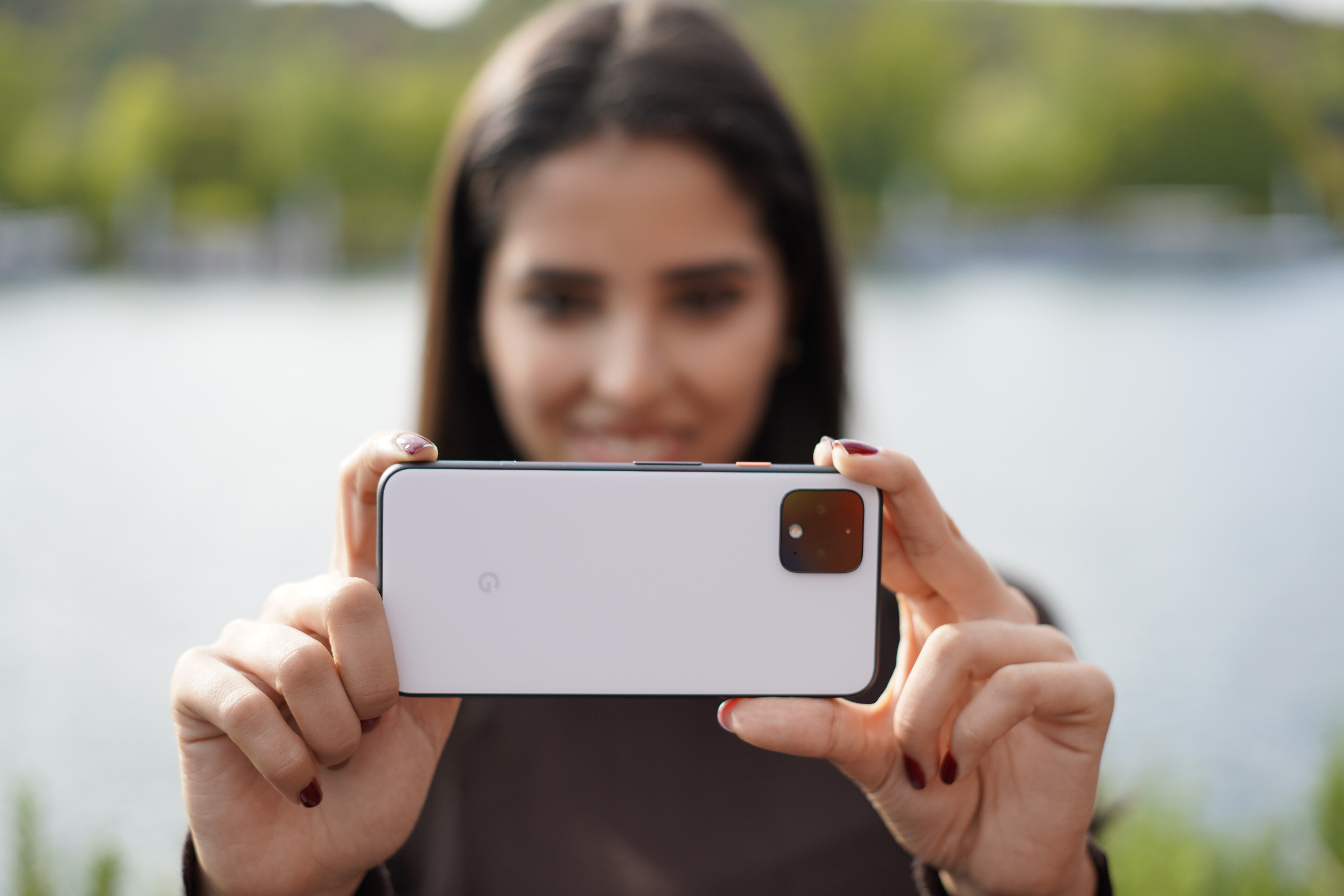

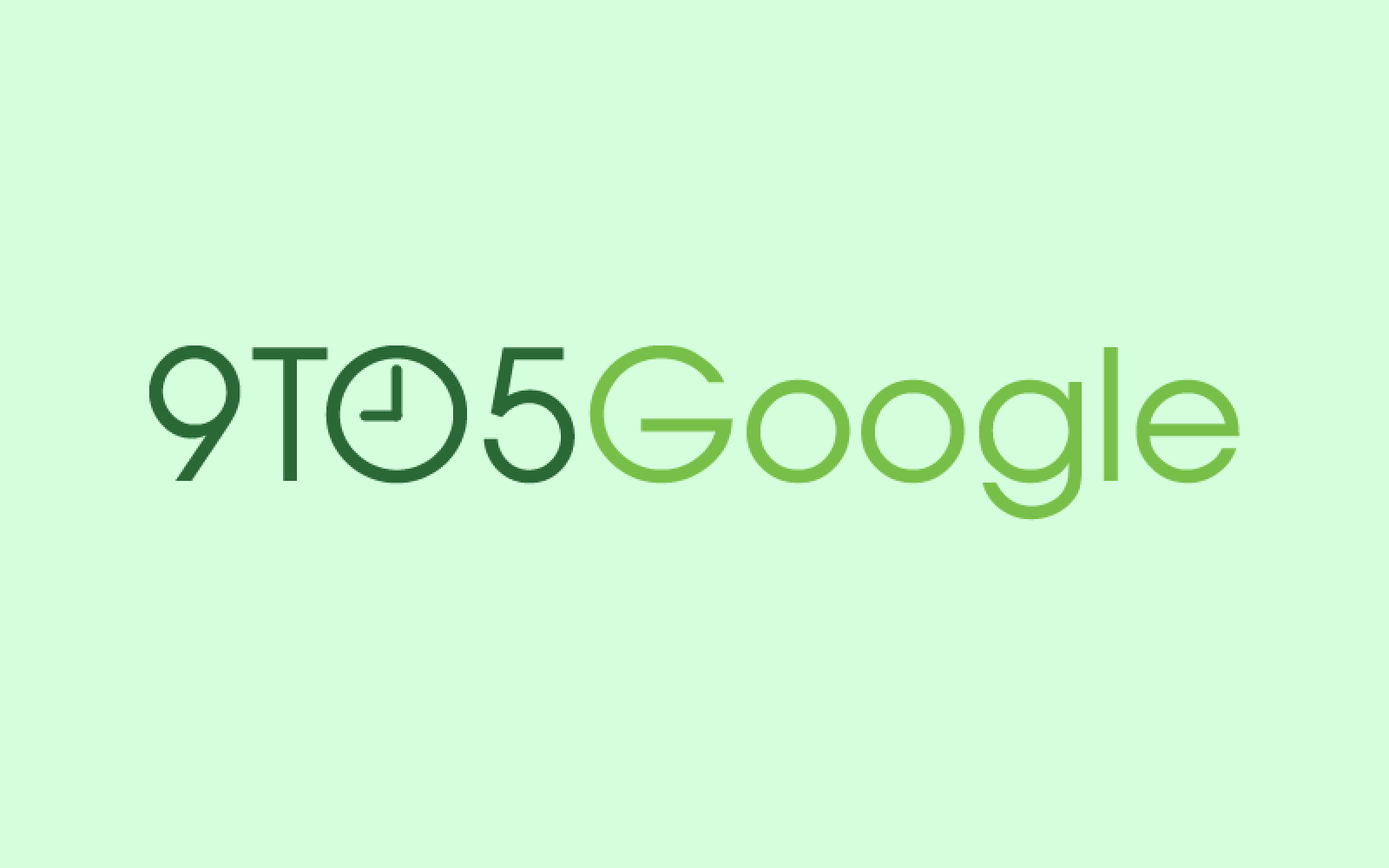
DXOMARK encourages its readers to share comments on the articles. To read or post comments, Disqus cookies are required. Change your Cookies Preferences and read more about our Comment Policy.